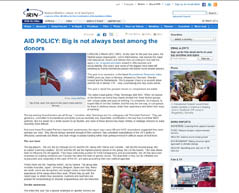March 8, 2012
Source: IRIN News
 Every year for the past five years, the Madrid-based organization, DARA International, has tracked the major international aid donors and ranked them according to how well the apply a set of agreed principles related to effectiveness and accountability. And every year some of the biggest have been left smarting by finding themselves placed well below much smaller players.
Every year for the past five years, the Madrid-based organization, DARA International, has tracked the major international aid donors and ranked them according to how well the apply a set of agreed principles related to effectiveness and accountability. And every year some of the biggest have been left smarting by finding themselves placed well below much smaller players.
This year is no exception. In the latest Humanitarian Response Index, DARA gives top place to Norway, followed by Denmark, Sweden, Ireland and the Netherlands. The European Union is in seventh place and the US in dismal 17th – only Luxembourg and Italy score worse.
This year’s report has grouped donors so comparisons are easier.
The index’s lead author, Philip Tamminga, told IRIN: “When we looked at the donors we found they clearly divided into three distinct groups with unique styles and ways of working. It’s unrealistic, for instance, to expect Italy to act like Sweden, but this may be one way, in sub-groups, for them to address issues, share their experience and refine their ways of working.”
The top-ranking Scandinavians are all Group 1 countries, what Tamminga and his colleagues call “Principled Partners”. They are generous, committed to humanitarian principles such as neutrality and impartiality, and flexible in the way they fund their NGO partners. But it is easier for a small country to be flexible, and none of these donors has major military or strategic interests to make neutrality more difficult.
And even these Principled Partners have their weaknesses; the report says many UN and NGO respondents suggested they were perhaps too “nice”, they did not always demand enough of their partners, had unrealistic expectations of the UN’s ability to effectively coordinate aid efforts, and took refuge in pooled funding rather than getting involved in difficult issues at field level.
The next level
The big players – the US, the EU through ECHO and the UK, along with France and Canada – fall into the second group, the so-called “Learning Leaders”. ECHO and the UK are the highest-scoring donors in the group, the US the lowest. Their size allows them to influence the aid agenda. They have collectively pushed for more transparency and accountability; the UK has led a new emphasis on building resilience and Canada has taken the lead on gender issues. The downside is they can be inflexible and bureaucratic and, especially in the case of the US, are seen as pushing their own political agendas.
Finally there are the “Aspiring Actors”, led by Ireland. The group also includes Australia, Japan, Germany, Belgium, Spain and Italy. Many are small, some are facing their own budget crises or lack historical experience of the areas where they work. Where they do well, the report says, is where they specialize: Australia and Germany are praised for concentrating on disaster preparedness and risk reduction.
Gender awareness
The index this year has a special emphasis on gender. Donors are increasingly demanding some degree of awareness of gender issues from their partners, even though it can be simply an exercise in “ticking boxes”. There is clearly a lot of confusion about what is being demanded. More projects for women and girls? More women on the staff of local partners?
The UN Under-Secretary General for Humanitarian Affairs, Valerie Amos, contributes a chapter in which she argues for a much subtler view of gender issues. Men and women experience humanitarian crises very differently. Women drown in greater numbers in floods and tsunamis because girls are seldom taught to swim. In civil conflict men are more likely to die from violence, women from indirect causes. Girls suffer sexual violence, but so do boys. Young male refugees may be less likely to receive rations, or not know how to cook the food they get.
“Paying attention to women’s needs is, of course, essential,” she writes. “But gender is a broader concept. It looks at how society works, who has the power, and what roles different members of the society have. It helps us to understand the profoundly different ways in which men and women experience the same events, and to identify the different responses needed to keep them alive and healthy and to ensure their dignity in crisis situations.”
Short v long term
Another problem is the tension between emergency aid and longer-term measures – especially disaster preparedness and building resilience before a crisis. Emergency aid gets the attention and the funding, the before and after are neglected. It is an issue in virtually all the country case histories DARA describes – Chad, Sudan, and the Democratic Republic of Congo, Kenya and Somalia, Haiti, Colombia, Pakistan and the occupied Palestinian territory.
Tamminga says it was a problem when the index was set up five years ago and remains so. “I think it is inexcusable,” he told IRIN. “We know this needs to be done. All the political statements say we need to do more on prevention and preparedness. But the sad reality is that donor governments still maintain administrative barriers between humanitarian and development aid, and different funding envelopes.
“There’s no excuse at this point, and there should be no impediment. It’s the same populations which are vulnerable and susceptible to humanitarian crises, just as they are to underdevelopment and poverty.”
Share this